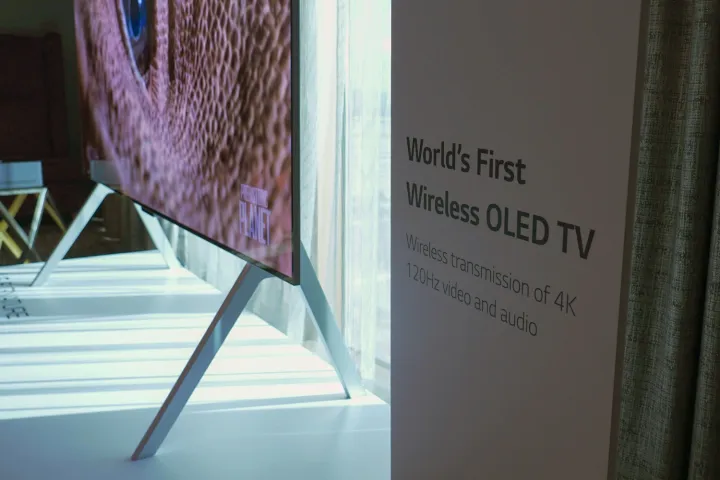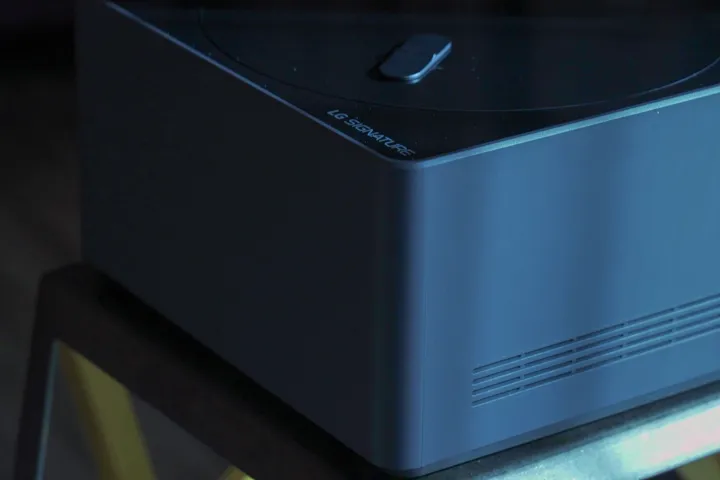
While LG has a solid track record of bringing its innovative tech to market so folks can actually buy it, a lot of what we see at CES is vaporware. This stuff is exciting to see amid the mayhem of the world’s biggest tech show, but then, all too often — poof — it’s gone, never to be seen again. That being the case, I tend to hold my excitement at bay until a product is in my hands for review.
And so I must confess, I forgot all about the M–Series wireless TV that LG showed me at CES earlier this year. That was a mistake because the wireless signal transmission LG has cooked up for its new TV series has broad implications for the future of TV, and we should be talking about it.
So, when LG recently reached out to let me know that it was shipping me a 77-inch version of its new wireless M-Series model for review and invited me to visit its facilities for a briefing on the wireless tech behind the TV, my excitement was rekindled. Now that we know that both the TV and the tech behind it are real, let’s take a look at why this development is so exciting.
Wait, this is a … what is this?

If you’ve been thinking that wireless video doesn’t sound new, you’d be right! Wireless video devices have been around for many years, and the newest ones aimed at working with TVs — like this wireless HDMI kit from Monoprice — can get some basic wireless video jobs done for a very reasonable price. But these devices have considerable limitations:
- They add hardware and require their own power source, neither of which is convenient.
- They accommodate only one HDMI connection, which means they need to be used with an HDMI switcher of some sort if more than one device is to be connected to the TV.
- They are limited to 4K resolution at 30Hz, which is inadequate for today’s game consoles, as well as a lot of online video content.
- They operate on frequencies that are often shared with other wireless tech in the home and are thus prone to interference.
- They often “drop frames,” which manifests as stuttered video.
That’s interesting, man. That’s interesting!

LG’s wireless solution is well-suited for typical TV use in a home. A wireless audio/video receiver is built into the TV display panel, and the transmitter is built into a black box — or, hub — which has all the ins and outs you would typically expect to find on the back of a TV. This way, consumers don’t have to do anything unfamiliar to get the TV working. Once everything is unboxed, you plug the cable box, game console, or streaming box into the black cube, then plug the black cube and TV into power, and that’s it. There aren’t any new steps, it’s just that some of the steps happen in a different location from the TV.
LG also uses a rather remarkably high-frequency band for its wireless technology, so that there’s very little chance other wireless devices will interfere with the video signal. Plus, the wireless signal can handle up to 30 Gbps worth of bandwidth, which means it can handle 4K video at up to 120 frames per second, along with uncompressed audio with virtually no latency. Theoretically, that means no degradation of picture quality for 4K Blu-rays or any other video source, and no lag for gamers.
Because the HDMI 2.1 spec calls for at least 40Gbps of bandwidth — if not the full 48Gbps of which the standard is capable — I understand why some may be initially concerned that the TV’s wireless technology may not be able to handle bandwidth-intensive video signals, like those coming from an Xbox Series X or a 4K Blu-ray player. I was too when I wrote this article. However, LG has since explained that once the video processor in the Zero Connect box has done its job with the full incoming video signal, the resulting “instructional” signal sent from the Zero Connect box to the TV is much less bandwidth intensive. In other words, 30 Gbps is well more than enough to get the job done without any degradation to video quality and integrity.
It really ties the room together, does it not?

Presently, LG’s wireless M-Series TV technology essentially eliminates one set of HDMI cables in a typical home entertainment system. While this may sound unremarkable, it actually goes a long way toward making installation simpler and prettier.
Homeowners pay professional installers and integrators hundreds to thousands of dollars to install conduit behind drywall, pull multiple in-wall rated HDMI cables through said conduit, and connect those cables to equipment that’s tucked away in an unseen location, all in service of getting a TV to look more like art than it does a TV in a room.
For around the same cost, we can now skip that song and dance, along with all the hassle that comes with it, and still get that look. All that’s needed is a power outlet in close proximity to the TV.
But that’s just the immediate impact this technology will have on TVs. Eventually, we may see wireless transmission protocol normalized between all AV devices. Imagine if your Xbox, PlayStation, cable box, Blu-ray player, and audio system all used the same wireless technology — perhaps all the headaches and hassle involved with HDMI cables could go away forever. Wouldn’t that be great?
The answer to that rhetorical question is yes.
This is our concern, dude

I’m excited and hopeful. But I have some concerns.
I’ve not thoroughly tested this technology. And while I appreciate LG’s confidence in it, my 25 years of experience in this game tells me that I — and, eventually, LG’s customers — are going to discover some bugs. This is just how first-gen technology works. I am optimistic, however, that if issues are discovered, LG will be quick to deploy a patch, as I have witnessed them do many times in the past.
I’m also not sure that 30 feet of line-of-sight will be ample range for very long. Eventually, this tech will need to see through walls like Superman and travel a distance a bit longer than 30 feet.
But mostly, I’m concerned about how cagey LG might be with this technology. I have it on good authority that LG is applying for all kinds of patents and trademarks, but how broad will LG’s ownership span?
Will LG be generous and license its technology out for a reasonable fee, or will it get stingy and demand a king’s ransom? Or worse, refuse to license it at all?
The worst-case scenario, though, is that this technology doesn’t go anywhere beyond the M-Series. I point to WiSA’s wireless audio technology as an example of a great technology that the world simply refuses to adopt, even after a solid decade of it being awesome.
Far out, man. Far out
The future of video is wireless, and it doesn’t have to be far out ahead of us. LG’s M-Series TV is here today, but it’s going to take a combination of consumer interest and industry support to make it fly.
LG set up the pins because now it’s time for us to knock ’em down.



